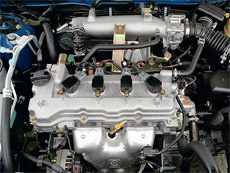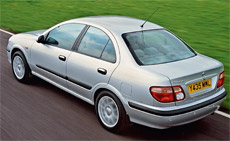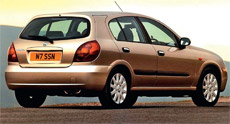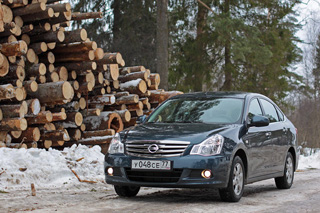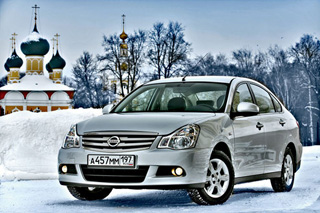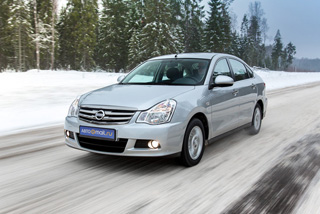Nissan Almera Thailand test drive since 2011
A blurry gaze. Nissan almera N16
 Almera with the N16 index at first seems to be an imitation of its predecessor. But on a more detailed examination, differences from version N15 are found
Almera with the N16 index at first seems to be an imitation of its predecessor. But on a more detailed examination, differences from version N15 are found The main features of the spot, quality, modesty and reliability. Yes, outwardly, the car is a box with a salon that does not shine with a design or equipment, but made from high -quality finishing materials. In addition, a more flaw -out low -commissive is still looking for. Well, as for the N16 that appeared in 2000, with a certain resemblance to its predecessor, its interior acquired pretentiousness and hyperfunctionality (for any, even the smallest object there is its own niche). In addition, the exterior of Almera has become much more exciting and bizarre. However, such positive properties of the previous model, such as a large margin of safety and the quality of the finish, were lost. In the pursuit of optimization of price and quality ratio, the Japanese reduced the bar in order to maintain a competitive cost (in peak, Korean automakers gaining momentum). As a result, compared to the previous generation car, ALMERA N16 causes much more complaints in terms of reliability
However, it cannot be said that all the changes in N16 went to her harm: outwardly, the car really became more memorable. Of course, not everyone liked it, since not everyone likes the design in the style of biode design. Therefore, in 2006, the Japanese replaced it with the Almera Classic model.
Be that as it may, and there are many complaints about the reliability of the second generation model. So, there are defects in an electrician (the central lock is spontaneously triggered, the light bulbs on the dashboard light up and without light, the nest under the lamp in the headlights, etc.) is melted. But the body panels are more successful in rust than that of N15 (the latter, as you know, had certain problems with this).
Nissan almera N16
Body characteristics
Hitchback sedan
Number doors 4 3/5
Sum of places 5 5
Length, mm 4425 4184
Width, mm 1695 1706
Height, mm 1440 1448
Wheel base, mm 2535
Road clearance, mm 140
Suspension:
Front
The back
independent, with racks like MacPherson
dependent, spring
Front drive
Brakes:
Front
rear
disk ventilated
drum (disk)
Gas tank volume, l 60
Passive safety rating, protection:*
adults
pedestrians
****
**
Acceleration to 100 km/h, s ** 10.8
Max. speed, km/h ** 180
Fuel consumption, l:
city
highway **
10,2
5,9
* According to EURONCAP.
** Data for a car with a 1.8 liter engine and manual transmission.
The second -generation Almera installed gearboxes of two types of automatic and mechanics. In other cars, an automatic transmission usually turns out to be a less durable and non-resistant unit, but Almera is an exception: just a mechanical box is the least reliable (after some time bearings may make a nickel, as a result of which the checkpoint will have to be either repaired or changed). If nothing is an unsettled happens, then the care of any of the two boxes comes down to the change of oil every 60 thousand km.
A minimum on the suspension and steering and the steering control: ball supports, shock absorbers, silent blocks usually withstand at least 120 thousand km of run, and steering stitch tips in the steering system are subject to replacement once every 70 thousand km.
Alas, Almera is not very strong anthers of the hinges of equal angular velocities (cord) and shock absorbers, and it is advisable to follow them with each. In addition, the brake system behaves quite well on our roads: they designed a car for Europe and Japan, where roads differ almost hospital purity. Therefore, the creators did not provide for the likelihood of mud in the details of the brake system in such quantities as in Russia.
It should not be said that Almera N16, perhaps, should not be an unsuccessful machine. Still, in the aggregate of consumer qualities, she took a big step forward compared to her predecessor. At the same time, the car does not differ the famous Japanese quality and reliability: Almera began to resemble past Korean cars. So is it worth buying it? You can, of course, but only if your previous car is not Almera N15.
Approximate prices in Moscow: from 200 (ALMERA with a 1.5 liter of 2000 release engine) up to 460 thousand rubles. (ALMERA with a 1.8 liter of 2006 engine).
The advantages and disadvantages of the model
Advantages
Tested ergonomics, dense suspension, comfortable salon
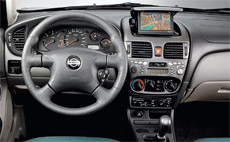
The interior is good in its own way: in Japanese verified from the point of view of ergonomics, there is no less place in the cabin than in similar machines, noise insulation is quite worthy. The equipment is pleasantly surprising, as well as the number of different pockets and niches for small objects. That's just the quality of finishing materials of the penultimate Almera is much lower than that of N15, the plastic is quite hard and booming. It’s not necessary, in general.
With regard to the running qualities, nothing out of the model in this generation should be expected: the handling is not too bright, although confident, the machine slow down without unnecessary enthusiasm, and it accelerates without much haste. However, it feels, in turn, the dynamic capabilities of even the basic version are quite good, especially in the urban speed range. There are no obvious failures in terms of sledges: the car does everything well, but the city is just great. So, the almera N16 is very maneuverable, and the solid suspension allows it to be confidently moving even in the perbole modes. One but: the smoothness of the course is far from record by the standards of the class. Almera is good through the more or less decent autobahns, but in broken sections of the road, her behavior can upset (for long-term flights along the highway it is adapted worse than many competitors performing in golf class).
I must say, powerful diesel engines on Almera were put, but in our country such models are practically not found. Most of the cars used by us are equipped with one of two power units. The youngest with a working volume of 1.5 liters develops 90-98 hp, while a 1.8-liter engine produces from 114 to 116 hp. A little, of course, but well -chosen gear
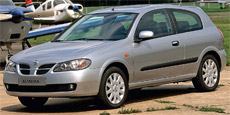 the numbers of boxes (mechanical, at least) allow you to quite famously accelerate in small (up to 80-100 km/h) limits. True, on the highway, both motors, as they say, are sour. Unfortunately, not everything is smooth and in terms of their reliability. Firstly, both power units are sensitive to the quality of the fuel used. Secondly, the 1.8-liter engine is noticed in the overspending of the oil. Otherwise, everything is quite acceptable. It is recommended that the small then with the replacement of oil and filters be carried out every 15 thousand km of run. The timing belt does not need to be changed, since its functions are successfully performed by a strong and durable chain.
the numbers of boxes (mechanical, at least) allow you to quite famously accelerate in small (up to 80-100 km/h) limits. True, on the highway, both motors, as they say, are sour. Unfortunately, not everything is smooth and in terms of their reliability. Firstly, both power units are sensitive to the quality of the fuel used. Secondly, the 1.8-liter engine is noticed in the overspending of the oil. Otherwise, everything is quite acceptable. It is recommended that the small then with the replacement of oil and filters be carried out every 15 thousand km of run. The timing belt does not need to be changed, since its functions are successfully performed by a strong and durable chain. Flaws
Weak engines, capricious electrician, low smoothness
